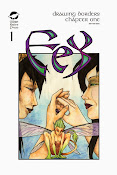Or, What I Want in an E-Reader
While I'm fascinated by e-Readers, I should say right off that I'm also a traditional book person and always will be. I collect books and I'm a traditional hand bookbinder. I prefer reading something with actual pages (for various reasons largely having to do with tactility and the senses). But, I'm also a technophile, and I can certainly see the utility in e-Readers.
Why I, a Book Person, Needs an e-Reader
For some time now, I've been thinking about buying an e-Reader. Aside from the coolness of a new gadget, the idea of being able to have a whole bunch of reference books (and yes, probably some fiction) in a portable, vaguely book-shaped package is very appealing. And my former bookbinding teacher and current mentor has all kinds of out-of-print and extremely rare bookbinding books in photocopy form that he's gradually scanning and making into pdfs. Many e-Readers can also read pdfs as well as ePub and whatever proprietary format they might have. So an e-Reader would be immensely useful (and did I mention cool?).
I had almost decided on one of Sony's devices, as they seemed to be better with pdfs, at least according to what I read at the time. I might even have bought one then, but Bill hadn't found work yet, so our spending was rather . . . restricted, shall we say. But then the iPad was announced, and oh! how I want one. Not only does it have its own native e-Reader app, but you can also get versions of Kindle and Nook apps, making Amazon and Barnes & Noble's libraries available, too. (Interestingly, the iBookstore is currently only available to US users, but since I'm mainly after free out-of-print fiction and the ability to read Joe's bookbinding pdfs, that's not a major concern, and I expect it's temporary, anyway).
Anyway, I can't afford an iPad just yet, though I've got some teaching gigs coming up, so I may not have to wait too long. But none of this is quite what made me start this article.
No, what I've been thinking about most is the issue of design.
Design makes Everything Better, Even Books
Some of you may know that I came to Nova Scotia to study design at NSCAD, and though I didn't finish with a design degree (being too easily distracted by printmaking and photo and the ability to brush up my bookbinding skills with actual book arts courses), I did take enough design courses to be thoroughly indoctrinated in the belief that design can make anything better.
But consider the book. In addition to being written, books are designed, and not just the covers. If they weren't, a book would look just like the stack of pages your printer spits out, and who wants to read that?
But of course, book design is usually invisible. It's there to help remove barriers to the reader becoming immersed in the story by making the text as easy and natural to read as possible. Why then, you might ask, don't all books look the same on the inside? It's because some books have better design than others, and also because there are some things a designer can do with layout and typeface and spacing that don't effect how we read to a huge extent, but which give each book a slightly different character.
Please, Can I Have my Book and Read it, Too?
So as I'm reading the info on the various e-Readers and e-Reader apps for iPad (and also iPhone, since I've already got one of those), I keep wondering, "But where's the design?" Most e-Readers offer various user-configurable typefaces, font sizes and colour schemes. That's all very nice, and I can certainly understand some readers wanting different sizes of type (it's why large print books exist, after all), but what happens to those subtle differences of character that a skilled book designer imparts to the pages of any given book?
I don't really think I want 20,000 Leagues Under the Sea to look exactly the same as Mona Lisa Overdrive, even on pages of pure text.
What I want is an e-Reader that allows the reader to choose typesizes, sure, and maybe even colours, if black-on-white hurts their eyes. Heck, even let them choose between serif and sans-serif, and even between a selection of faces. But please, can I have a default that was designed by an actual book designer? Can I have an e-version that maybe even uses the same design as its print version? E-Readers (iPhone excepted) generally have big enough screens nowadays that you can even use the same page numbering as the print version, don't they?
Sure, keep all the configurable options for readers who want that sort of thing, but please let me have my book designed.
(And here's a great article on the subject from Wired: Why E-Books Look so Ugly by Priya Ganapati. Edit: and six hours after I posted this, I found this article from the NYT, via Twitter: Further Thoughts of a Novice E-Reader by Verlyn Klinkenborg, who has a pretty cool name.)
Subscribe to:
Post Comments (Atom)







No comments:
Post a Comment